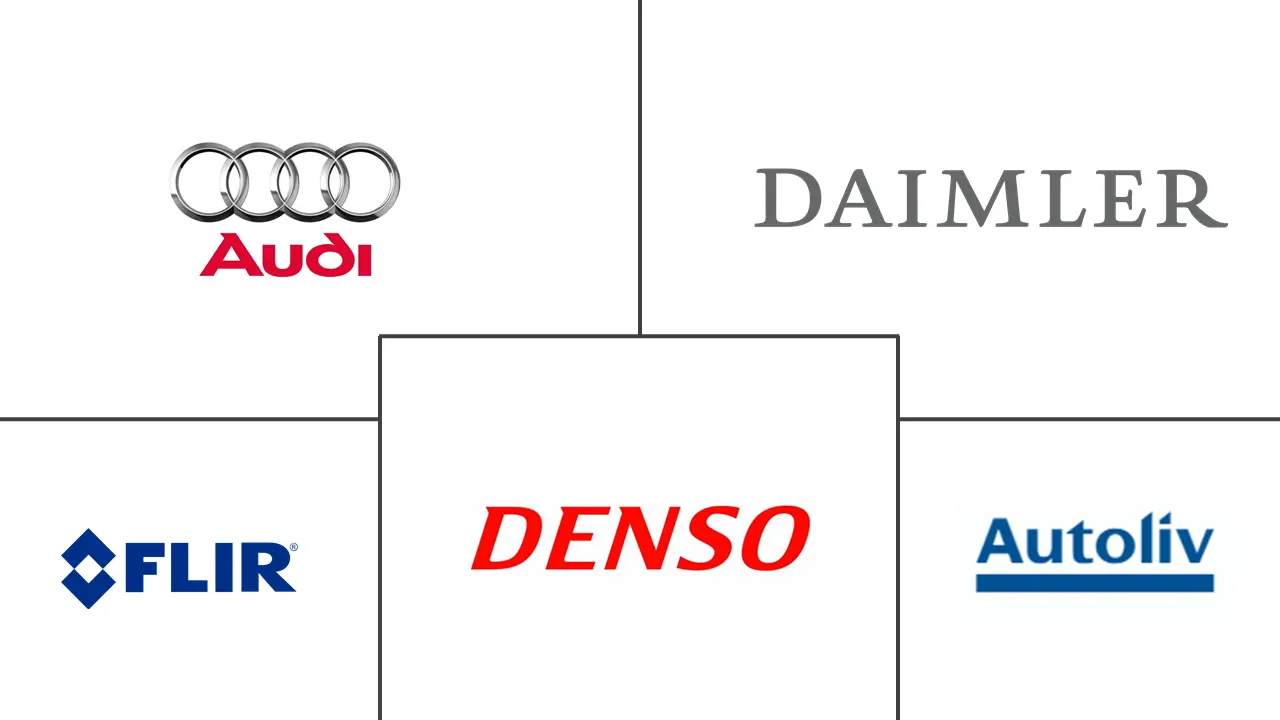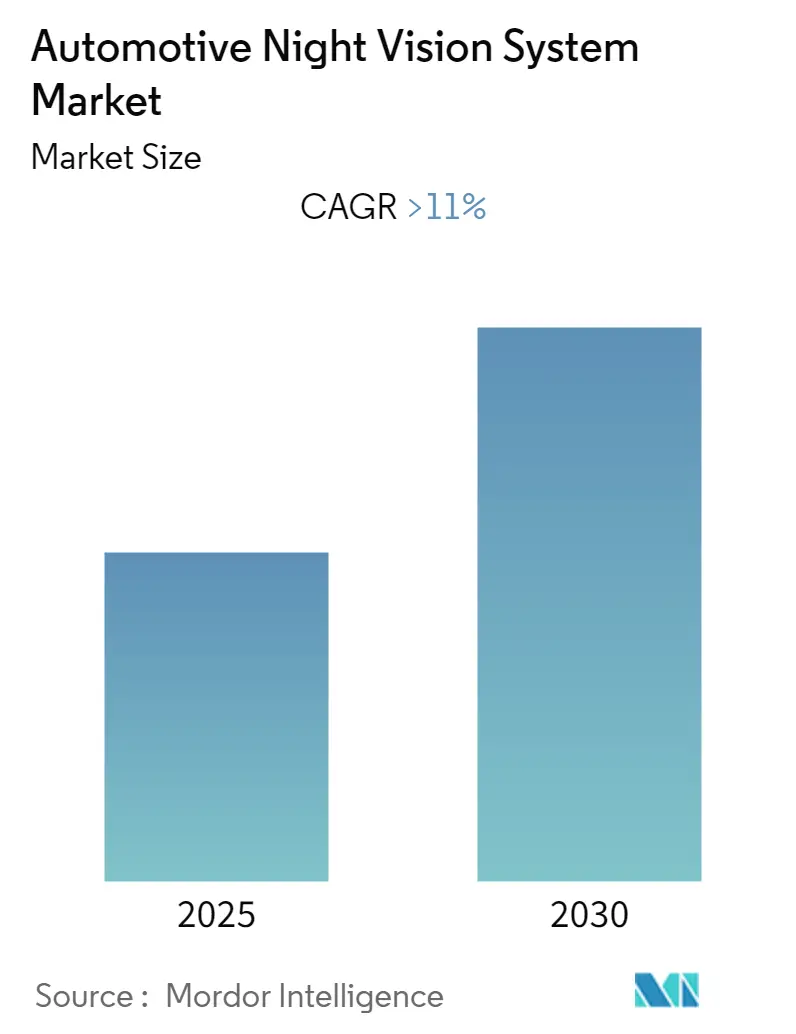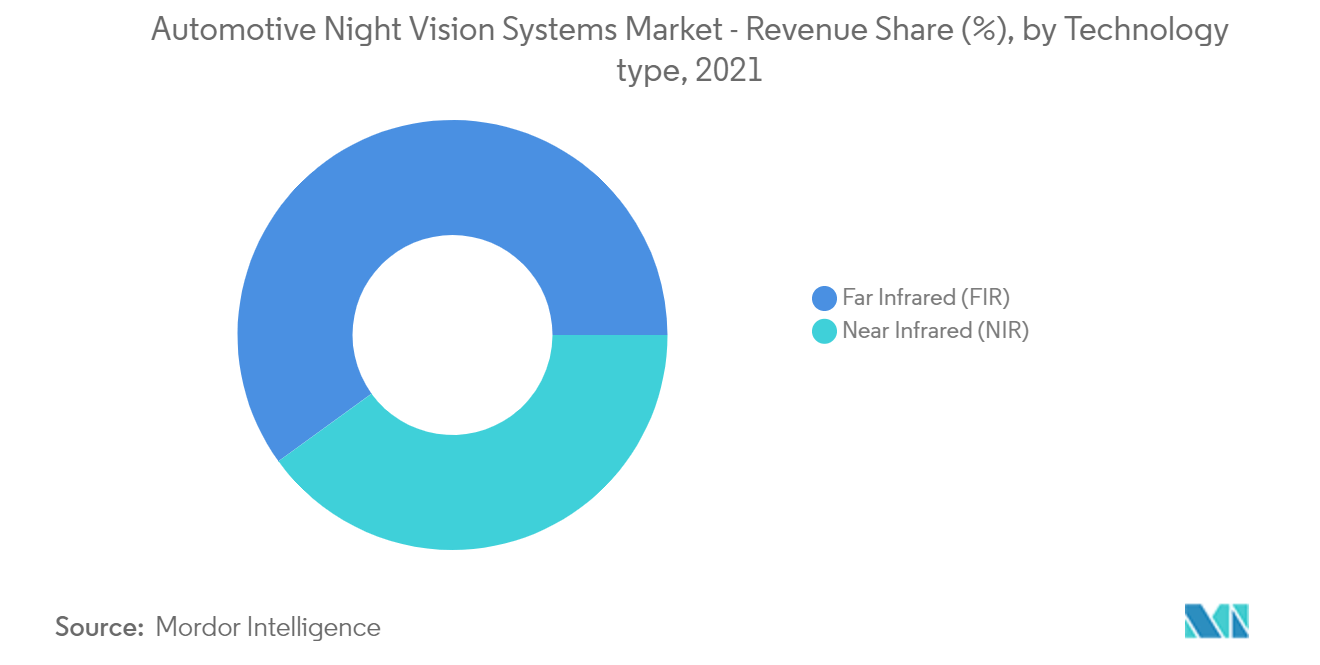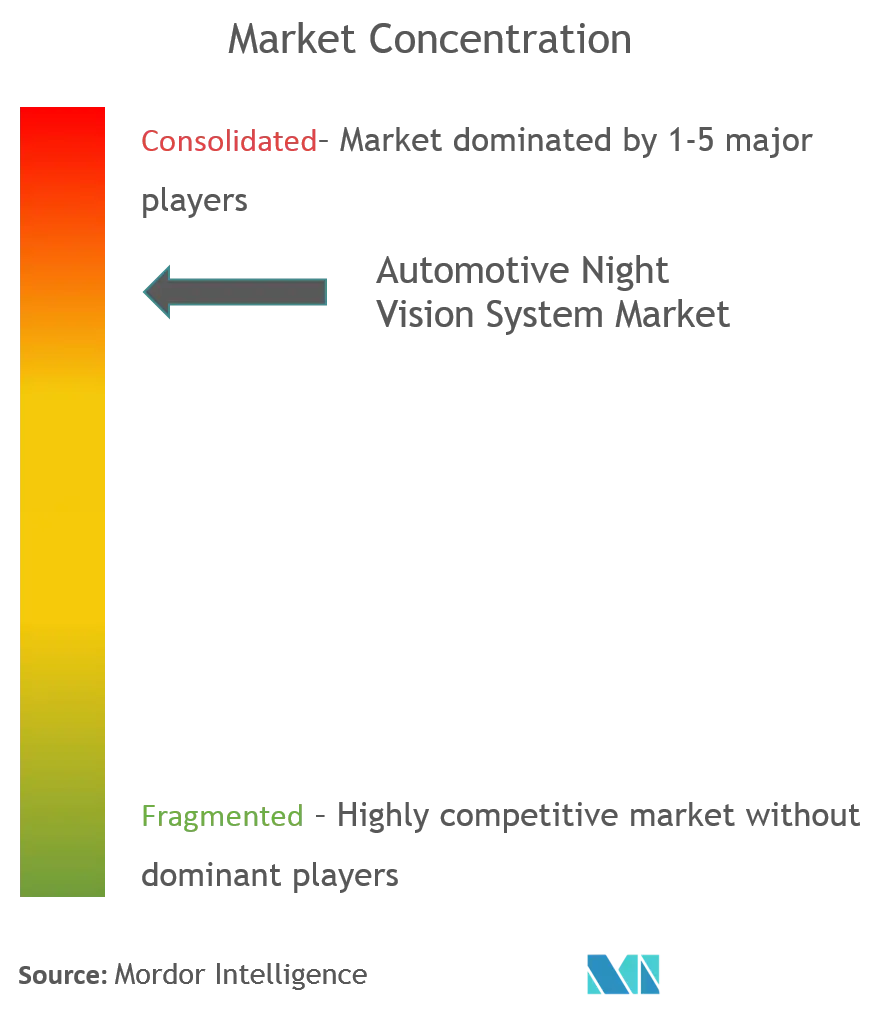Automotive Night Vision System Market Analysis
The Automotive Night Vision System Market is expected to register a CAGR of greater than 11% during the forecast period.
The Covid-19 pandemic had a negative impact on the market. With low vehicle sales reported In 2020, the significant market potential for night vision systems was shallow. Also, with significantly less or almost zero vehicular movements, the aftermarket sector of the industry did not register many sales. However, with the expected increase in sales of passenger vehicles and increased awareness of safety in both passenger and commercial vehicles, the market is looking forward to reviving and growing economically back to pre-covid conditions.
Over the medium-term growing public awareness of road safety, increased sales of luxury cars, and the inclination of automobile manufacturers to develop more advanced technologies to prevent accidents (due to the enactment of stringent regulations by governments and safety organizations) are likely to support demand in the market.
Though night vision systems (NVSs) are currently available only for luxury cars, they are expected to be available in the mass mid-car segments by the end of 2023. However, the high prices of night vision systems pose a significant threat, as the technologies used in systems, like sensors and display units, are expensive.
Europe is the largest Automotive Night Vision System Market Despite the Chinese market experiencing sluggish growth, the world's largest automobile market. On the other hand, Asia-Pacific is expected to grow significantly attributed to the proliferation of automotive & automotive component manufacturers in APAC countries, including China, India, and Japan.
Automotive Night Vision System Market Trends
Far Infrared Segment Expected to Grow Significantly During the Forecast Period
Night vision sensor systems are becoming more common in vehicles. Different methods using infrared sensors are suggested in the literature to detect cars in far-infrared (FIR) images. However, these systems still have low vehicle detection rates, and their performances may be enhanced. Images from cameras with infrared are expected to improve the driver's perception under low-light conditions. The main drawback of this system is that it cannot display the images at the right time to avoid distracting the driver from road traffic.
Currently, many road accidents occur during times of low visibility, such as at night. However, most existing automobile algorithms and detection systems are focused on daylight vehicle detection with visible spectrum cameras. Studies are going on regarding night-time vehicle and vehicle lamp detection. Still, these detections are generally affected by different factors, like rain, low illumination, and camera exposure time.
- In May 2021, FLIR Systems announced the availability of its first European thermal imaging regional dataset and the third in a series of thermal imaging datasets for machine vision testing. Designed to help researchers, developers, and auto manufacturers enhance and accelerate work on safety, advanced driver assistance systems (ADAS), automatic emergency braking (AEB), an autonomous vehicle (AV) systems, the dataset features thousands of annotated thermal images of daytime, night-time and various weather scenarios from six cities across Europe.
- In April 2021, South Korea's Hanwha Systems Co., Ltd. announced that it would participate in a consortium for developing night vision cameras for autonomous driving vehicles. The consortium is led by erae AMS Co., Ltd., a South Korean electrical component supplier. It aims to develop 3D fusion cameras by 2025 by combining daylight and thermal imaging.
Asia-Pacific Region Anticipated to Grow at Significant Level During the Forecast Period
Asia-Pacific dominated the market and is expected to witness the same trend in the coming years, followed by Europe and North America. China is the leader in the automotive industry in every aspect, whether it is the sales or production of vehicles. The country's growing demand for luxury vehicles contributes significantly to the night vision system market.
- The Chinese market for electric vehicles is swiftly growing, and China holds more than half of the electric vehicle market share globally. In 2021, around 2.9 million battery electric vehicles will be sold in China, an increase of 162 percent compared to 2020. In the same year(2021), about 603,000 plug-in hybrid cars were sold in China, an increase of 140 percent compared to the previous year (2020).
The demand for more ADAS functions in electric cars, such as night vision systems, is also growing with the electric car market. Several key players operating in the market are designing strategies in this regard. The market is also witnessing the launch of the latest models with advanced night vision systems. For instance,
- In April 2021, South Korea's Hanwha Systems Co., Ltd. (Hanwha Systems) announced that it would participate in a consortium for developing night vision cameras for autonomous driving vehicles. The consortium is led by erea AMS Co. Ltd, a South Korean electrical component supplier. It aims to create 3D fusion cameras by 2025 by combining daylight and thermal imaging. Hanwha Systems plans to apply its intelligent thermal imaging engine module technology, Quantum Red, released in 2020, to develop XGA-class (1024 x 768 pixels) night vision system.
- In December 2020, the VOYAH brand of Dongfeng Motor Corporation (Dongfeng Motor) revealed VOYAH FREE, a mid to large-sized intelligent electric SUV, in Shenzhen. The active night vision system used in the vehicle supports 150-meter distant vision and AI recognition warning.
Automotive Night Vision System Industry Overview
The market is highly consolidated by major players, like DENSO Corporation, Valeo, Autoliv Inc., Daimler AG, and Hella. DENSO Corporation has dominated the market. The key players are proactively focusing on new product developments & launches to gain a competitive advantage in the market.
- In January 2021, Volvo Cars announced that Night Vision, developed by Raytheon Commercial Infrared, will be available in the Volvo XC90 SUV, unveiled at the North American International Auto Show. The Volvo Night Vision system has a 50 percent wider field of view and a deployed combiner mirror head-up display (HUD) that folds flush to the dashboard when not in use.
- In August 2021, Daimler unveiled the 2021 Mercedes-Benz S-Class equipped with Night View Assist Plus, a night vision system that uses infrared technology with a unique camera to provide a clear outlook of the road while driving at dark. This system automatically focuses its headlights on nearby pedestrians and can detect cold objects too.
- In December 2019, Valeo unveiled its PictureBeam Monolithic technology; the first high-definition LED intelligent lighting solution to improve safety at night. This technology can project around 4,000 pixels onto the road from a single lighting module; PictureBeam Monolithic produces a far-reaching beam of light for an optimal field of vision and offers the best anti-glare function available to date.
Automotive Night Vision System Market Leaders
-
FLIR Systems Inc.
-
DENSO Corporation
-
Audi AG
-
Daimler AG
-
Autoliv Inc.
- *Disclaimer: Major Players sorted in no particular order
Automotive Night Vision System Market News
- In January 2022, Opel announced that its new SUV Grandland is the first Opel model to feature the Night Vision system, which turns night into day and increases all road users' safety at dusk and in the dark. The infrared camera is concealed under the Opel Vizor in combination with the adaptive IntelliLux LED Pixel Light. The lighting technology with 168 LED elements,84 per headlamp, provides a seamless adaptation of the light beam according to the driving situation and surroundings.
- In September 2021, Hanwha Systems Co., Ltd. (Hanwha Systems) announced that the company and Truwin Co., Ltd. (Truwin) had agreed to set up a joint company to develop and produce infrared sensors and other sensors for vehicles by the end of 2021. The new joint company will make infrared sensors for autonomous vehicles' night vision systems.
- In August 2021, Audi announced that the 2022 Audi e-Tron S Sportback Quattro is releasing Standard 20-inch wheels on a 255-section tire to provide the grip; gonzo 21- or 22-inches are optional, with a 285 cm sectional width. Advanced driving aids like Audi active cruise and lane assists are standard kits, and the night vision assistant is optional.
- In January 2021, Teledyne Technologies announced that it is acquiring FLIR, a thermal imaging and night-vision technology company, for USD 8 Billion.
Automotive Night Vision System Industry Segmentation
An automotive night vision system uses a thermographic camera to increase a driver's perception and see the distance in darkness or poor weather beyond the reach of the vehicle's headlights. The report also covers the market size and forecast for the automotive night vision system market across the regions mentioned.
The Automotive night vision system market has been segmented by technology, display, component, and geography. The market has been segmented by technology type into far infrared (FIR) and near-infrared (NIR). The market has been segmented by display type into navigation systems, instrument clusters, and HUD.
The market has been segmented by component type into night vision cameras, a controlling units, display units, sensors, and other components. By geography, the market has been segmented into North America, Europe, Asia-pacific, and the rest of the world. For each segment, the market sizing and forecast have been done on the basis of value (USD billion).
| Technology Type | Far Infrared (FIR) | ||
| Near Infrared (NIR) | |||
| Display Type | Navigation System | ||
| Instrument Cluster | |||
| HUD | |||
| Component Type | Night Vision Camera | ||
| Controlling Unit | |||
| Display Unit | |||
| Sensor | |||
| Other Components | |||
| Geography | North America | United States | |
| Canada | |||
| Rest of North America | |||
| Europe | Germany | ||
| United Kingdom | |||
| France | |||
| Italy | |||
| Spain | |||
| Rest of Europe | |||
| Asia-Pacific | China | ||
| Japan | |||
| India | |||
| South Korea | |||
| Rest of Asia-Pacific | |||
| Rest of the World | South America | ||
| Middle-East and Africa | |||
Automotive Night Vision System Market Research FAQs
What is the current Automotive Night Vision System Market size?
The Automotive Night Vision System Market is projected to register a CAGR of greater than 11% during the forecast period (2025-2030)
Who are the key players in Automotive Night Vision System Market?
FLIR Systems Inc., DENSO Corporation, Audi AG, Daimler AG and Autoliv Inc. are the major companies operating in the Automotive Night Vision System Market.
Which is the fastest growing region in Automotive Night Vision System Market?
Asia-Pacific is estimated to grow at the highest CAGR over the forecast period (2025-2030).
Which region has the biggest share in Automotive Night Vision System Market?
In 2025, the Europe accounts for the largest market share in Automotive Night Vision System Market.
What years does this Automotive Night Vision System Market cover?
The report covers the Automotive Night Vision System Market historical market size for years: 2019, 2020, 2021, 2022, 2023 and 2024. The report also forecasts the Automotive Night Vision System Market size for years: 2025, 2026, 2027, 2028, 2029 and 2030.
Our Best Selling Reports
Automotive Night Vision System Industry Report
Statistics for the 2025 Automotive Night Vision System market share, size and revenue growth rate, created by Mordor Intelligence™ Industry Reports. Automotive Night Vision System analysis includes a market forecast outlook for 2025 to 2030 and historical overview. Get a sample of this industry analysis as a free report PDF download.







